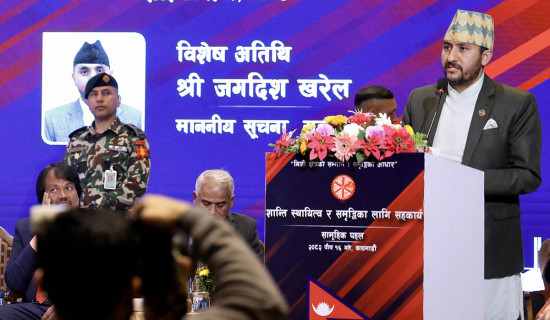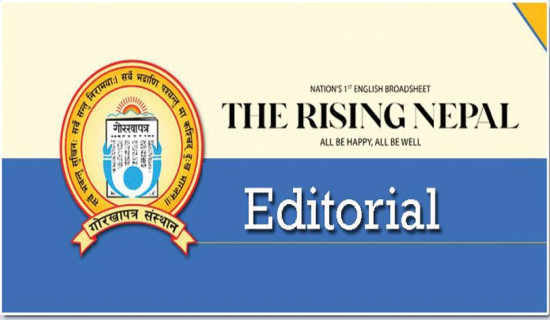- Thursday, 1 January 2026
Be On Alert Against Rain-induced Ruins
The first drops of a rainfall in Nepal often bring a sense of relief. The earth smells fresh, and farmers look up to the skies with hope and prayers for a good harvest. The rainy season, primarily spanning from June to September, contributes to about 80 per cent of the country's annual rainfall. It nourishes crops, replenishes rivers, and plays a critical role in sustaining the livelihoods of millions. Agriculture, which makes up 23.5 per cent of GDP, heavily depends on this seasonal downpour.
It is not the thunder that kills, but the silence before the storm, as said by Rumi. The very rains that nurture life also bring destruction and death. Year after year, the same pattern repeats: landslides in the hills, floods in the plains, waterborne diseases in urban and rural areas, and widespread destruction across the country. According to the Zurich Climate Resilience Alliance (Z-CRA), climate-related disasters account for around 65 per cent of all disaster-related annual deaths in Nepal. Alarmingly, nearly 100,000 people currently live at extremely high risk of future displacement due to flooding or earthquakes.
In 2021, Nepal experienced 144 flood events, up from 91 in 2020, devastating thousands of hectares of paddy fields, particularly in the western regions. The following year, over 200 lives were lost to monsoon-triggered landslides and floods, as reported by the Nepal Economic Forum (NEF). In urban areas, cities like Kathmandu faced severe disruptions, with the 2024 monsoon rainfall flooding streets and paralysing transportation.
In flood-prone districts such as Bardiya, Saptari, and Rautahat, families brace themselves every year for rising rivers. A single night of intense rain can undo a farmer’s year-long toil, washing away crops, livestock, and hope. Yet, despite the annual suffering, necessary measures such as proper drainage, sustainable land use, and riverbank management are frequently neglected. Random construction continues on fragile land, riverside trespass remains unchecked, and poor sanitation aggravates health crises.
This silent disaster stretches Nepal’s fragile healthcare system. Floodwaters contaminate drinking water sources, leading to outbreaks of cholera, typhoid, and other waterborne diseases. Overwhelmed drainage systems cause waterlogging in cities, hindering access to hospitals and emergency services. The repeated devastation from heavy rains is not just a result of natural forces; it reflects systemic failure and lack of preparedness. Disaster response is often prioritised over prevention.
But where are the long-term solutions, sustainable drainage systems, disaster preparedness plans and public awareness campaigns? How many more monsoons must we suffer before we begin to act, not just react? Both the government and citizens must take shared responsibility. The government must invest in early warning systems, strengthen infrastructure, regulate construction in vulnerable areas, and ensure that emergency supplies and trained personnel are ready.
Meanwhile, citizens should stay informed, dispose of waste responsibly, avoid illegal invasion, and engage in community preparedness programmes and afforestation efforts. Nepalis cannot afford to treat the rainy season as an unavoidable calamity. With proper planning, improved infrastructure, and collective action, the suffering caused by rainfall can be significantly reduced. It's time to transform how we respond; not just to survive the rain, but to live with it safely.





-square-thumb.jpg)










